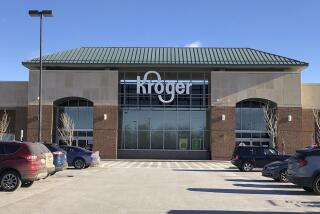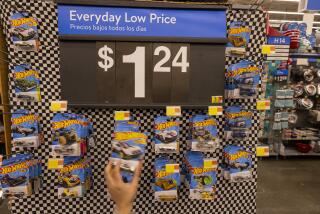BEHIND BARS : Those mysterious stripes may stump consumers, but they lay it all out in black and white for retailers: what’s hot and what’s not--and even why.
- Share via
Safeway Stores figured out a few years ago that shoppers bought more candy bars when they were stocked at front-end checkstands than when placed only on racks in the middle of stores. So the Oakland-based chain started stocking the sweets up front.
Ralphs Grocery recently found in a store-by-store analysis that sales of fresh pasta had “really exploded” in certain of its locations, according to Al Marasca, executive vice president of the Compton firm. That enabled the company to expand the space for that product only in those stores where demand was greatest.
What led to these changes were bar codes, those ubiquitous black and white stripes on products from peanut butter to kitty litter. To shoppers, the codes are best known for being pulled by a cashier across a window-like device in the checkout stand, which somehow translates them into a price that flashes onto a screen.
But bar codes also have a secret life--as speedy providers of facts and figures about what people buy and why.
In addition to streamlining the checkout process and saving grocers the cost of tagging many items, bar codes are being used increasingly to help manufacturers and retailers make smarter decisions about which products to sell and how to market them.
Manufacturers depend on the data to find out how well their products are moving and what promotions work best to stimulate sales. At Ralston Purina Co. in St. Louis, maker of Chex cereal, Wonder Bread, dog food and other products, bar code data is “relied upon in different degrees in our different divisions, but all of them do use it,” said spokesman Patrick Farrell.
The technology, which uses laser beams to scan bar codes, is worthy of “Star Wars.” Scanning was pioneered in the early 1970s by Kroger, the big Cincinnati-based grocery company. Now, according to industry figures, nearly 17,000 of the nation’s 30,000 supermarkets (not including small mom-and-pop stores) have laser scanning equipment.
Here’s how the process works:
Before any information about a product can be collected, a supermarket company makes an entry in a host computer at headquarters.
The file usually contains a 10-digit number represented by the bar code plus the current price. The first five digits stand for the manufacturer, whose number is assigned by the Uniform Code Council in Dayton, Ohio. The council, which maintains a database of about 60,000 companies from 77 different countries, also determines the specifications for each bar code, including the width of stripes and the contrast between the bars and the background.
The next five digits, assigned by each manufacturer, signify the product, with variations by flavor, size or weight. A 16-ounce box of Rice Krispies, for example, would have a slightly different code from a 24-ounce package. And an 8-ounce container of strawberry-flavored Dannon yogurt would have a different number from an 8-ounce container of blueberry.
Back at the checkout stand, a cashier passes the bar code across a window embedded in the counter that covers the inner workings of the laser scanner. The scanner can read the code in the proper order, even if the item is upside down. If the scanner recognizes the code as one contained in the store’s computer, it sounds a beep and flashes a brief product description and the price on a screen. It also tallies another sale in that store for that product.
Although stores could analyze the data on a daily basis, “most don’t have the time,” noted Jerry Morton, who runs Store Systems Consulting in Lawrence, Kan., and advises supermarkets about scanning equipment.
More commonly, the headquarters computer retrieves information on a weekly basis from each store, and then the chain sells the data to services that analyze it for manufacturers. Some large chains get as much as $1 million a year just for selling the data, according to Tony MacNeary, vice president of retailer client services for one such company, Information Resources Inc.
IRI and A. C. Nielsen Co., both based in Chicago, use the vast stores of data to track the success or failure of products and promotions. By tracking data from a representative sample of stores, these companies can analyze how an individual item (say, Diet Pepsi) or company (PepsiCo) is faring during a certain period or in a given region. They can also determine whether sales of bean dip go up if a supermarket puts taco chips on sale.
“For the retailer or manufacturer, we can see whether it’s worth more to run a feature ad in a newspaper or a huge display in a store,” MacNeary said. “Combining them might be even more effective.”
As part of its service, Nielsen analyzes a wealth of data from 15,000 U.S. households. Using special hand-held scanning equipment at home, participating residents scan the groceries and other products they have bought. They note such factors as whether the price was marked down or whether they used a coupon. Nielsen also takes into account what magazines and newspapers these people read to find out what ads they may have seen. Participants are rewarded with gifts and trips.
Although manufacturers have started putting such data to good use, retailers have yet to tap the full potential of scanner information, many observers say. Instead of using scanner data and computers to develop automated reordering of products, an estimated 98% of the nation’s groceries still use manual methods. Usually, store personnel must walk the aisles with hand-held scanners that read bar code tags on the shelves.
“Nobody is getting more than 10% of value out of the data,” said W. Frank Dell, vice president in the New York office of Cresap, a Towers Perrin company that consults for food and consumer products companies.
Safeway Stores is an exception. In May, 1983, the big chain hired a developmental psychologist named Louise H. Booth to head an in-house marketing research organization. Her team collects and analyzes scanner data for other retailers and for manufacturers, such as Procter & Gamble, Ralston Purina and PepsiCo.
“We not only earn some money by doing research,” said Booth, manager of Safeway Scanner Marketing Research Services. “We learn the answers to questions (our clients are) asking.” Safeway also analyzes its own data, looking for ways to boost sales, as it did with candy bars.
Armed with scanner data, manufacturers can get influential retailers such as Safeway on their side by proving that shelf space for their products can mean added profit all around.
Take kiwis. In 1984, the New Zealand Kiwifruit Authority went to Safeway to learn how best to market the exotic fruit to U.S. customers. In a series of tests, Safeway showed that added display in the produce area plus special advertising and a reduced price could boost weekly kiwi sales to more than 450 per store from 25.
“It was so useful that we’re thinking of updating it in the next year or two,” said Hillary A. Brick, with the kiwi marketing board in Oakland.
(To be sure, kiwis and other fruits and vegetables don’t have bar codes affixed to them. To ring up produce purchases, cashiers punch in a two-digit code that prompts the computer to look up the price for that item. The data is then analyzed in the same way as other bar code information.)
Eventually, as the system becomes even more sophisticated, Booth expects Safeway’s service to help manufacturers target customers more effectively. “P&G; might want to send a coupon to people who buy disposable diapers, in particular people who buy the other brand, or to anybody who buys baby food,” she said. “This is a way for P&G; to get a mailing list based on the purchase behavior of a household.”
More to Read
Eat your way across L.A.
Get our weekly Tasting Notes newsletter for reviews, news and more.
You may occasionally receive promotional content from the Los Angeles Times.











